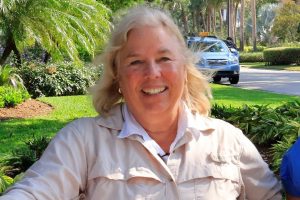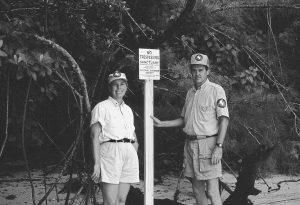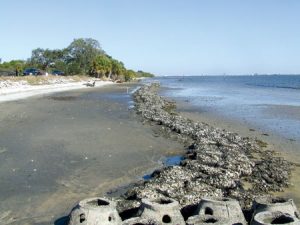
Even before she finished unpacking after her move to Tampa, Ann Paul had called Florida Audubon to sign up as a volunteer. Her first assignment: a hot and sweaty job planting cordgrass to prevent erosion on Bird Key. Then, as a reward, the team was invited to visit the nesting colonies.
“We went into a cove and it was so huge and so incredible,” she recalls. “I’d never seen anything like it before and I knew then I was going to help protect them in any way I could.”
Fast-forward nearly 30 years and Paul is retiring as Florida Audubon’s regional coordinator for Tampa Bay, protecting nesting birds in colonies that have been deemed “globally important” sites by BirdLife International.
Originally hired by Robin Lewis to spend six months identifying where the nesting birds were foraging, she conveniently “forgot” that the assignment was limited and just kept working.
“We knew where the birds nested but we needed to know where they were finding food,” she said. “It’s not quite as simple as diving into the water off an island — most chicks eat food from freshwater wetlands so we needed to protect those ‘grocery stores’ as well as the island colonies.”
At the time, vast swaths of south Hillsborough County were still cattle pasture and the wetlands on those sites provided a high quality and easily accessible source of food for birds.
Her first “real” job with Audubon was working as a seasonal warden for the coastal island sanctuaries, where she posted no-trespassing signs on islands and patrolled the shores on weekends protecting the birds from curious boaters.
“One of the questions we got a lot — from birders, reporters and policymakers — was how many birds are out there and what are the population sizes of a specific species. We couldn’t answer those questions so we shifted our focus.”

Working with her soon-to-be husband Rich Paul, who was regional director for Audubon at the time, they surveyed the islands in and near Tampa Bay looking for birds.
“It wasn’t just wading birds,” she said. “We were also looking at beach-nesting birds on Shell Key, Passage Key and Three-Rooker Island.” Initially, there was no protection for those birds but the Pauls persuaded the Florida State Parks to post signs on Three-Rooker and then pushed Pinellas County to buy out private owners on Shell Key by donating the proceeds from the first-ever Florida Birding and Wildlife Festival.
Long List of Accomplishments
Ironically several of the region’s top nesting locations are on “spoil” islands, created when channels were dredged to allow large ships to access ports in Hillsborough Bay and the Alafia River. The Richard T. Paul Alafia Bank Bird Sanctuary consists of spoil islands originally dredged in the 1930s by a phosphate company and are now managed in a partnership between Mosaic and Audubon.
The two largest spoil islands are still active; Port Tampa Bay manages them with input from Audubon. They’ve been so successful that they’re listed as globally important birding sites.
“The criteria to determine globally significant sites are very rigorous but working with the National Audubon Society, our data could meet that criteria,” she said.
Working in a partnership with Port Tampa Bay, Army Corps of Engineers and Florida Fish and Wildlife Commission, the dredgedmaterial is placed so that it doesn’t impact nesting or migrating birds. “It’s a big effort on everybody’s part but we’ve been successful,” Paul said.

A more recent accomplishment is the 2018 statewide survey of reddish egrets, which documented at least 400 nesting pairs in Florida. The largest number of pairs was found in the Florida Keys but the Tampa Bay region came in second with 85 to 92 pairs nesting in either Hillsborough or Pinellas counties.
“They’re still extremely rare birds but we know much more about where they’re nesting now than we ever have.”
Although Paul doesn’t include the multi-year, multi-million dollar initiative to protect the shorelines of the Hillsborough Bay islands from erosion as among her top accomplishments, people who have followed her work credit her with the long-term protection of those shorelines.
“Ann really was the impetus for building the breakwaters that protected those islands,” said Marianne Korosy, Florida Audubon’s director of bird conservation. “She has a good relationship with Mosaic and could justify nearly $10 million to protect the islands from erosion.”
That budget has grown dramatically over the last years. “Ann proved the value of the project,” Korosy said.

“She’s a formidable fundraiser,” adds Nanette O’Hara, who worked with her for years as outreach coordinator of the Tampa Bay Estuary Program. “Ann’s willingness to work with all community stakeholders and her deceptively beguiling approach were legendary. She was never deterred by the first ‘no.” She just kept plugging away until she got to yes.’”
“Ann stepped brilliantly into the impressive footsteps of Rich Paul, and not only sustained his memory but built on his legacy in Tampa Bay. Her determination and passion resulted in significant enhancement and expansion of bird conservation areas in the region.”
Luckily for the birds in the Tampa Bay region, Paul has only retired in terms of earning a paycheck. She’s open to working on projects that protect and conserve habitat across the region. Contact her at annpaul26@icloud.com with your ideas.
ABOUT THE COVER PHOTO: Ann Paul rescued an egret tangled in monofilament in 2005, risking both herself and the other birds nesting on the island. The story has a happy ending though — read more at http://baysoundings.com/legacy-archives/sum05/rescue.html.
Photo by Holly Greening
